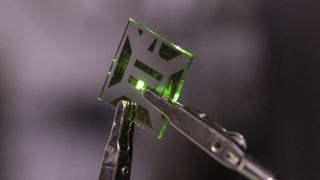The best OLED TVs could get even brighter – here's how
A new electrode design could show the way forward

After a brighter OLED TV? Researchers at the University of Michigan may have cracked OLED's dim brightness problem, with a new electrode that can "liberate" 20% more light from respective screens – at the same time as increasing energy efficiency and improving the battery life of portable OLED displays (smartphones and the like).
The electrode design effectively improves the emission of light from an OLED screen's diodes, with a blog post on the Univerisity of Michigan's website stating that "the approach prevents light from being trapped in the light-emitting part of an OLED, enabling OLEDs to maintain brightness while using less power."
- Here are the best OLED TVs
- What is OLED?
- And what is Mini LED?
This electrode is intended to replace the transparent model typically used between the panel and its glass surface, using a 5nm (nanometer) silver and copper layer that better directs light towards the glass – with far less light being lost to the sides of each electrode.
But this could go even further, we're told. Co-author of the study Changyeong Jeong says researchers were "able to free up about 34% of the light by using unconventional materials with special emission directions or patterning structures" – adding that manufacturers could even "liberate more than 40% of the light" using their processes.
Light at the end of the tunnel
OLED TVs are notorious for their dim output, which is the next big hurdle for OLED manufacturers to overcome. It's something that's already changing, as with the new OLED evo panel used in the LG G1, which also outputs 20% more peak brightness than its 2020 predecessor, the LG GX.
However, LG Display tells us that larger TV sizes have the biggest impact in this regard, with a 83-inch panel size being best for their own luminance improvements – despite the LG G1 not currently coming in that size.
The real test for TV makers is whether they can apply widespread brightness solutions across their OLED TV ranges, in every size and iteration – getting closer to the 1,000 nits brightness level desired for HDR, or even the heady heights of QLED TVs that can output several times that.
Get daily insight, inspiration and deals in your inbox
Get the hottest deals available in your inbox plus news, reviews, opinion, analysis and more from the TechRadar team.
- Check out the best OLED TVs you can buy
Henry is a freelance technology journalist, and former News & Features Editor for TechRadar, where he specialized in home entertainment gadgets such as TVs, projectors, soundbars, and smart speakers. Other bylines include Edge, T3, iMore, GamesRadar, NBC News, Healthline, and The Times.

